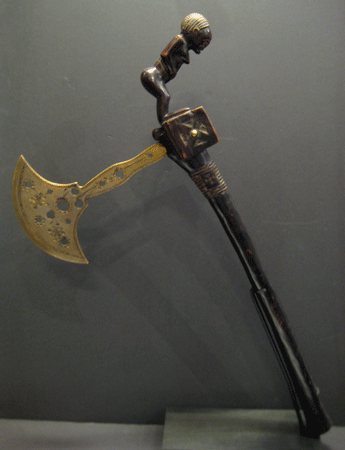Chokwe Ceremonial Axe, 19th Century CE - 20th Century CE
9.65 x 21.26
LSO.557
The Chokwe (Tchokwe) of Angola and Zaire are a highly complex and multifaceted group. The mwanangana (local ruler) held sway over a deeply ritualised and religious environment where every element,...
The Chokwe (Tchokwe) of Angola and Zaire are a highly complex and multifaceted group. The mwanangana (local ruler) held sway over a deeply ritualised and religious environment where every element, no matter how disparate, would be forced to obey his authority. In order to make manifest the validity of his rule, the rulers and other members of the elite often hired specialist artesans and craftsmen whose skills exceeded those of the Songi and Fuli, semi-professional craftsmen who were responsible for the production of utiltarian and everyday objects. The specialists manufactured regalia and magicoreligious artefacts, such as ancestor statues and representations of Tshibinda Ilunga, the semi-mythical founder of the Chokwe and their work is highly refined and of great value. It is likely that the current item was never used in a practical sense. The construction of the handle, the asymmetry of the finial and the length of the axe stock all count against it in mechnical terms. Furthermore, the blade is made from copper/
brass alloy that would not have been suitable for chopping wood or food, just as the shape of the whole argues against usage as a throwing axe. It was therefore purely a ceremonial item for a high-status person. The shaft is plain and is a dark wood with some wear on the bottom third. There is a banding with a bilaterally imposed cruciform composed of triangles surrounding a central diamond. The body of the finial repeats this on a much larger scale, centering on a brass stud which anchors the blade into the finial. It is surrounded by a standing female figure in a bent-over position with her hands positioned on her midrift. She appears to be waering a banded hat with elevated dot design. The blade is long and slender with a splayed end. Decoration is via twelve drilled holes and geometric/floral designs stamped into the metal. This is a remarkable and unusual object.
brass alloy that would not have been suitable for chopping wood or food, just as the shape of the whole argues against usage as a throwing axe. It was therefore purely a ceremonial item for a high-status person. The shaft is plain and is a dark wood with some wear on the bottom third. There is a banding with a bilaterally imposed cruciform composed of triangles surrounding a central diamond. The body of the finial repeats this on a much larger scale, centering on a brass stud which anchors the blade into the finial. It is surrounded by a standing female figure in a bent-over position with her hands positioned on her midrift. She appears to be waering a banded hat with elevated dot design. The blade is long and slender with a splayed end. Decoration is via twelve drilled holes and geometric/floral designs stamped into the metal. This is a remarkable and unusual object.
